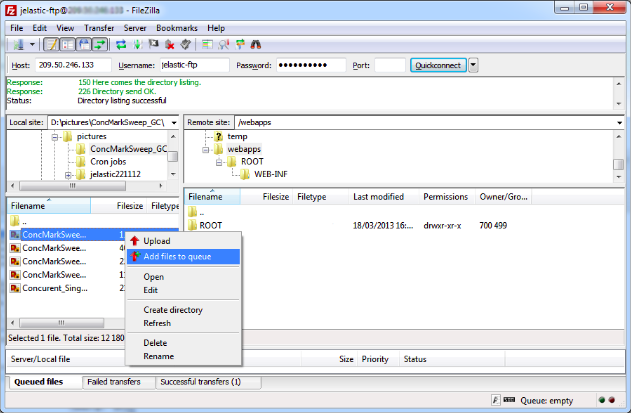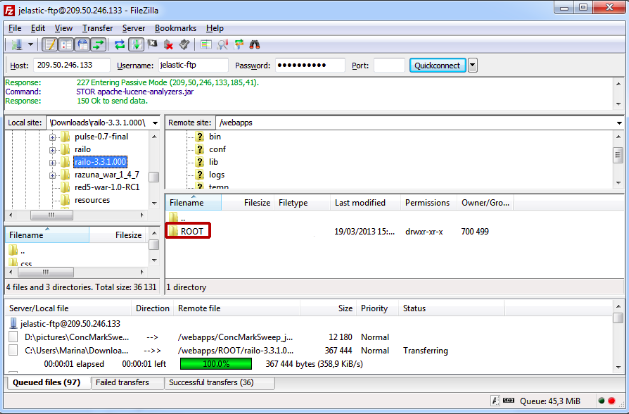File Transfer Protocol (FTP) is a standard network protocol used to transfer files from one host to another over a TCP-based network.
FTP is built on a client-server architecture and uses separate control and data connections between the client and the server.
For secure transmission that hides (encrypts) the username and password, and encrypts the content, it is used FTP secured with SSL (FTPS).
Apiqcloud supports both FTP and FTPS.
Unlike HTTP, the FTP protocol is stateful: you establish a control connection for the duration of an FTP session that typically spans multiple data transfers.
FTP usage in Apiqcloud:
- uploading/downloading resources
- downloading and reading logs for analysing
- editing configurations
- syncing files
- deploying applications (not recommended)
With Apiqcloud FTP feature is available for both application servers and databases.
To benefit from FTP with Apiqcloud you need to meet three requirements:
- to have FTP client installed (for example, FileZilla)
- to have compute node added to the environment
- to attach Public IP for the node in your environment.
Let’s go step-by-step the process of adding FTP to your Apiqcloud environment:
- Create Environment
- Install FTP
- Using FTP
- Transfer Files
- Download Log Files
- Synchronize Files
- Edit Configuration Files
- Deploy Application via FTP
- Switching FTPS
- Reset FTP Password
- State Custom FTP Password
- Uninstall FTP
Create Environment
1. Log in to the Apiqcloud dashboard.
2. Click Create environment to set up a new environment in Apiqcloud.
3. In the opened wizard select application server (e.g.Tomcat) or database (e.g. MySQL) and switch on Public IP.

Wait just a few seconds for your environment to be created.
Install FTP
- Click Add-ons button for your application server (or database).

- In the opened tab you’ll see the list of all applications available for adding to your environment. Find FTP and click Install.

- Сonfirm the installation by clicking Install button in the opened window.

-
After adding FTP to the Apiqcloud environment you’ll get the email with credentials for accessing (FTP links, Login, Password, IPs etc.).
Using FTP
Through FTP Client
1. Install and open any FTP client (e.g. FileZilla).
2. Enter your Host, Username and Password using the FTP credentials you’ve got in the email after installation. Perform the connection. 
3. Now you can see the list of the config folders in your FTP client.
4. You can make the changes you need (download, copy, delete the files etc.) right from your FTP client.
5. If you refresh the data in the config tab for your server (or database) in the Apiqcloud dashboard, you’ll see all changes made through FTP client.
Through Browser
1. Click Add-ons button for your application server (or database).
2. Find FTP in the list of applications. There you’ll see the list of IPs available.
3. Click on the IP link. In the opened browser tab fill in your FTP credentials (Username and Password which you’ve got in the email after installation).
4. After that the list of config folders are going to be opened. Here you can look through the files in all the folders.
Transfer Files
1. Install and open any FTP client (we use FileZilla as an example).
2. Enter your Host, Username and Password using the FTP credentials you’ve got via email after FTP installation. Perform the connection by clicking Quickconnect.

3. You can upload or download files simply by double-clicking on them. To transfer directories and/or multiple files select them, right-click the selection and then click on Upload/Download in the popup menu.
4. You can simply drag the files from one directory and drop them on the other one for transferring.
5. Add your files to the queue if you want to transfer them later.
6. One more useful feature is the directory comparison. To quickly see differences between files on the local machine and the server, choose View > Directory Comparison, select either compare file size or compare modification time and click Enable.
Deploy Application via FTP:
Note: We don't recommend to deploy your apps in such a way because the application you've deployed won't be shown in Apiqcloud dashboard, so if you want to redeploy or delete your application you have to do this manually. Also, such a deployment procedure is not suitable for the GlassFish application server.
Let's consider a short example on how to deploy Railo to your Apiqcloud Environment through FileZilla.
1. Install and open any FTP client (we use FileZilla as an example).
2. Connect to your environment via FTP: Enter your Host, Username, and Password and click on Quickconnect button.
3. Copy your application files into the ROOT folder (or create another context for your app and copy your files in it).
4. Now you can return to Apiqcloud dashboard and make sure that everything is ok. For that click Open in browser button for your environment.

